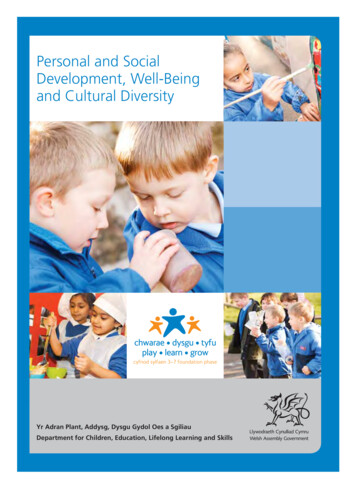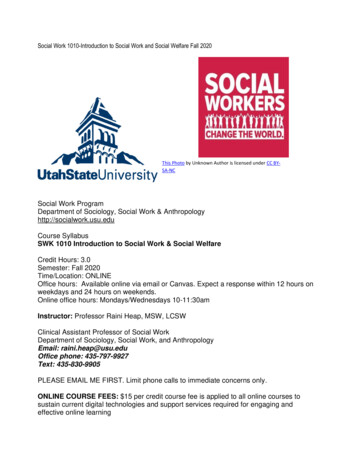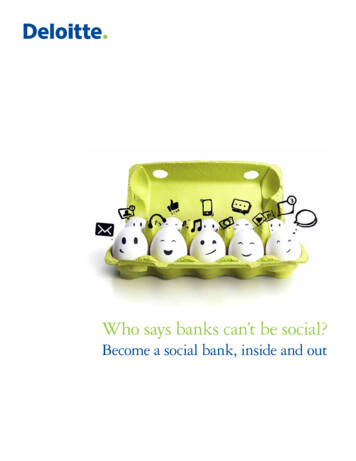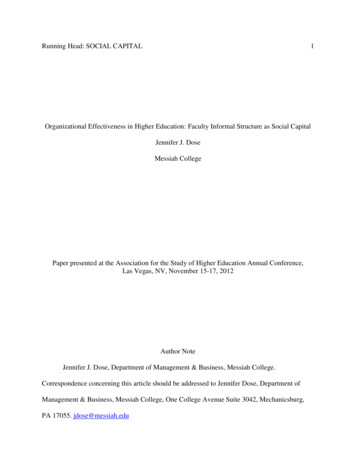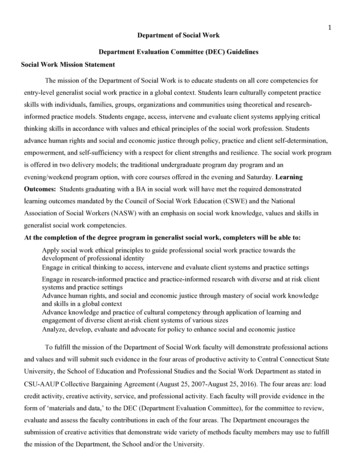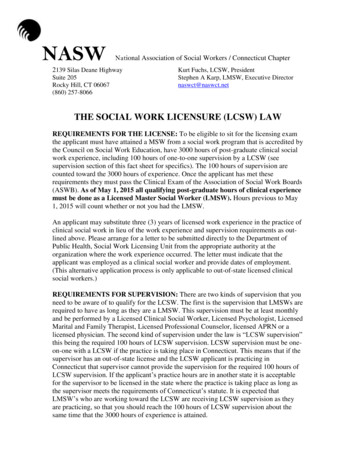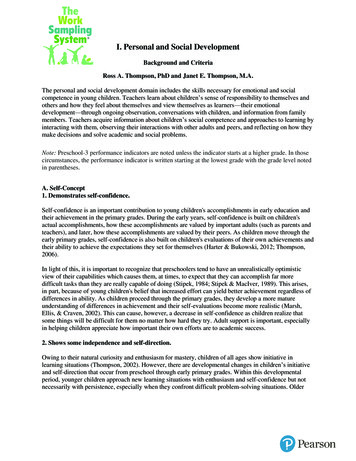
Transcription
I. Personal and Social DevelopmentBackground and CriteriaRoss A. Thompson, PhD and Janet E. Thompson, M.A.The personal and social development domain includes the skills necessary for emotional and socialcompetence in young children. Teachers learn about children’s sense of responsibility to themselves andothers and how they feel about themselves and view themselves as learners—their emotionaldevelopment—through ongoing observation, conversations with children, and information from familymembers. Teachers acquire information about children’s social competence and approaches to learning byinteracting with them, observing their interactions with other adults and peers, and reflecting on how theymake decisions and solve academic and social problems.Note: Preschool-3 performance indicators are noted unless the indicator starts at a higher grade. In thosecircumstances, the performance indicator is written starting at the lowest grade with the grade level notedin parentheses.A. Self-Concept1. Demonstrates self-confidence.Self-confidence is an important contribution to young children's accomplishments in early education andtheir achievement in the primary grades. During the early years, self-confidence is built on children'sactual accomplishments, how these accomplishments are valued by important adults (such as parents andteachers), and later, how these accomplishments are valued by their peers. As children move through theearly primary grades, self-confidence is also built on children's evaluations of their own achievements andtheir ability to achieve the expectations they set for themselves (Harter & Bukowski, 2012; Thompson,2006).In light of this, it is important to recognize that preschoolers tend to have an unrealistically optimisticview of their capabilities which causes them, at times, to expect that they can accomplish far moredifficult tasks than they are really capable of doing (Stipek, 1984; Stipek & MacIver, 1989). This arises,in part, because of young children's belief that increased effort can yield better achievement regardless ofdifferences in ability. As children proceed through the primary grades, they develop a more matureunderstanding of differences in achievement and their self-evaluations become more realistic (Marsh,Ellis, & Craven, 2002). This can cause, however, a decrease in self-confidence as children realize thatsome things will be difficult for them no matter how hard they try. Adult support is important, especiallyin helping children appreciate how important their own efforts are to academic success.2. Shows some independence and self-direction.Owing to their natural curiosity and enthusiasm for mastery, children of all ages show initiative inlearning situations (Thompson, 2002). However, there are developmental changes in children’s initiativeand self-direction that occur from preschool through early primary grades. Within this developmentalperiod, younger children approach new learning situations with enthusiasm and self-confidence but notnecessarily with persistence, especially when they confront difficult problem-solving situations. Older
children, by contrast, are more persistent, but are also more creative problem-solvers, proposing their ownideas, and approaching new learning opportunities with initiative and involvement (Bowman, Donovan,& Burns, 2000; Renninger, Hidi, & Krapp, 1992; Renninger & Wozniak, 1985).Developmental differences in self-direction also derive from changes in the growth of self-regulation(Bronson, 2001; Kopp & Wyer, 1994). The growth of self-regulation is viewed by developmentalscientists as consisting of development in three interrelated areas: inhibition (i.e., resisting a stronginclination to enact a primary response and instead acting in an alternative manner), working memory(i.e., holding information in mind while mentally working on it), and cognitive flexibility (i.e., being ableto switch perspective, attention, or mental focus). Together, these three developing competencies arecalled executive functions (Center on the Developing Child at Harvard University, 2011; Diamond & Lee,2011; Zelazo, Muller, Frye, & Marcovitch, 2003). The development of executive functions is based onsophisticated brain systems that mature very slowly, with some not becoming fully mature until earlyadulthood (Bunge & Zelazo, 2006; Diamond & Taylor, 1996). As a result, limitations in self-regulationand self-directionin young children derive from the immature brain, with developing competencies slowlyemerging as these areas of the brain develop and enable greater self-control of behavior, attention, andemotion. Similar brain maturity-compentencies development relationships occur in personal and socialdevelopment and related areas.B. Self-Control1. Follows simple classroom rules and routines with guidance.Research on early school achievement has found that children's cooperation with classroom rules andprocedures is directly associated with early academic success. McClelland, Morrison, and Holmes (2000)found, for example, that "work-related skills" (e.g., compliance with instructions; completion of work) inkindergarten predicted children's academic achievement three years later, even after controlling for earlieracademic achievement (see also Yen, Konold, & McDermott, 2004; and Alexander, Entwistle, & Dauber,1993).The preceding discussion of the growth of self-regulation—consisting of the specific competenciesknown as executive functions—helps to explain the slow progress of young children in their abilities tofollow classroom rules and routines. More specifically, in the early years children have difficultyfollowing rules and complying with routines on their own not because they are egocentric, but ratherbecause their immature brains support only limited capacities for self-regulation. In fact, it is easy to seehow each of the components of self-regulation—or executive functions—accounts for young children'slimited ability to follow rules without reminders. First, limited capacities for inhibition mean that youngchildren are likely to act impulsively rather than in a rule-governed manner (e.g., may speak out of turninstead of raising his or her hand). Second, limited working memory means that young children areunlikely to keep a relevant rule in mind as they are engaged in activity (e.g., cleaning up food items aftersnack time). Third, limited cognitive flexibility means that young children are likely to be cognitivelyfocused on a preferred activity (e.g., playing with sand in the sand table) rather than on a relevant rule(e.g., keeping all the sand in the sand table and off the floor).The slow growth of self-regulation, or executive functions, has been described by the Center for theDeveloping Child at Harvard University (2011) as metaphorically similar to the slow emergence of thechild's internal "air traffic controller" that manages competing demands for the child's attention, thinking,and behavioral regulation. Until that internal air traffic controller has fully matured (which takes many
years), children will struggle to manage these demands in a competent and flexible manner. In youngchildren, this can sometimes make them appear egocentric. This explanation for their behavior isincorrect, however, because in other respects young children's behavior is very nonegocentric (e.g., intheir sensitivity to others' feelings). By contrast, understanding the slow growth rate of children’s capacityto follow rules and routines (with regard to the development of executive functions) offers a much moreprecise and appropriate description of the growth of these abilities. In addition, research has shown thatcarefully designed classroom environments and routines for young children can assist them in selfregulation by aiding in the exercise of these executive functions (Diamond & Lee, 2011).2. Manages transitions.One of the important accomplishments of early childhood is the development of event knowledge: theability to understand and predict routine events in which the child participates (Hudson, 1993; Nelson,1989, 1993). As a consequence, young children become increasingly competent at understanding howactivities in the daily schedule are sequenced and conducted, and this enables them to prepare themselvesfor what comes next.Classroom transitions are thus one of the most significant self-regulatory challenges faced by youngchildren, especially if they are provided little preparation for transitions or little warning of changes inroutines, locations, or procedures. One reason is their limited cognitive flexibility discussed earlier. Oncethey have achieved enough understanding of the daily schedule to predict the day's events, for example, itcan be difficult for young children to flexibly adapt their expectations to a different schedule in order toaccommodate a new activity. Limitations in working memory are also relevant, especially if youngchildren are required to remember, during a transition, to enact a sequence of activities (e.g., stop adesired activity, clean up, go to another location, prepare for the next activity, and await furtherinstructions). As a consequence, children may proceed through part of the sequence before forgetting thenext steps and doing something else. Transitions thus become easier as children mature cognitively andneurobiologically. As the internal "air traffic controller" (Center on the Developing Child at HarvardUniversity, 2011) becomes more competent at remembering transitional events and understanding thestandard routine in relation to occasional changes to the routine, the child can become more adaptable.It is important to note that even as children are maturing in their self-regulatory capacities, limitations inthese executive functions can still be seen. For example, one of the characteristics of children in earlyprimary grades is their inflexibility with rules and routines: they insist that everyone adhere to the rules(even when they themselves sometimes forget), and they can be rigid in their insistence on a predictableschedule. This also derives from limits in cognitive flexibility, especially in the child's difficulty indistinguishing the broader purpose of the rule from apparent violations in its application, or understandingthe difference between the predictable schedule and one day's exception to it. This illustrates the slowmaturation of the higher brain regions underlying executive functions, and the fact that even as childrenare making progress on many aspects of self-regulation, other developmental challenges remain.For these reasons, teachers and caregivers can be helpful to children throughout this developmental periodby providing advance notice of changes in locations, routines, and events, and managing transitions byguiding children through the alterred sequences of activities required. They can also be helpful inproviding patient support when young children feel anxious in the face of unexpected changes to whichthey are having difficulty adjusting.
C. Approaches to Learning1. Shows eagerness and curiosity as a learner.There is considerable evidence that curiosity and eagerness to learn are early-developing, possiblyintrinsic characteristics in infants and young children (Jennings & Dietz, 2003). Besides developinginstructional methods to enlist children's natural curiosity, classroom teachers must ensure that children'sself-confidence as learners (discussed earlier) is supported and strengthened through their achievements inthe classroom (Thompson & Raikes, 2007). In addition, helping to provide multiple avenues for theexpression of their natural curiosity is important to children. This can mean the exploration of intereststhrough art, movement, construction, emergent writing activities, conversation, and other approaches.2. Attends briefly and seeks help when encountering a problem.Although children of all ages sustain attention to tasks that capture their interest, there are developmentalchanges in children's persistence in academic work. Generally, children devote more sustained attentionto tasks with increasing age. There are several reasons for this. First, children become capable of morefocused and sustained attention with age owing to growth in the self-regulatory competencies discussedearlier (Bowman et al., 2000). In particular, growth in inhibition enables children to be less distractableand better capable of focusing their attention and thinking on relevant task-related matters. Second, whenfaced with difficult cognitive challenges, older children are more likely to persist at the task than youngerchildren owing, in part, to the cognitive flexibility that enables them to devise more creative, novelproblem-solving approaches (Renninger, Hidi, & Krapp, 1992; Renninger & Wozniak, 1985). Bycontrast, younger children are more likely to give up when conventional problem-solving strategies fail.Third, developmental changes in attention and task persistence also emerge because of older children'sgreater experience and self-confidence in tackling cognitive challenges. Taken together, the abilities tobecome cognitively engaged in a task with focused attention, to persist in the face of challenges andfrustrations, and to generate new ideas and work on them are collectively described as "approaches tolearning." These develop significantly during early and middle childhood, and are critical to success inkindergarten and throughout elementary school (Alexander et al., 1993; Duncan et al., 2007).There are also individual differences in children's sustained attention and persistence in academic workthat derive from their learning orientation (Dweck, 2002). Some children with a "mastery orientation"tend to persist when faced with difficult challenges because of a belief that enhanced effort will berewarded with eventual success. Other children tend not to persist because they believe that their initialfailures are due to poor ability that they do not believe can be improved through increased effort; this cancontribute to learned helplessness in academic situations. These differences in learning orientation emergeearly, and thus are apparent by the time that children are in primary grades.3. Approaches tasks with flexibility and inventiveness.With increasing age, young children approach tasks with greater inventiveness and flexibility that cancontribute to more effective problem-solving approaches (Zelazo & Muller, 2004). To be sure, veryyoung children can be creative in their use of materials, but this creativity typically does not transfer tocreating better solutions to problem tasks. As children proceed through early primary grades, they are ableto approach cognitive challenges with new ideas after their initial solutions have failed, and are oftencapable of devising new solutions on this basis. This makes their creativity more problem-focused and
useful. Indeed, children's inventiveness contributes to their experimental and systematic strategies toproblem-solving (Kuhn, 2011).D. Interaction With Others1. Interacts with one or more children.An important contributor to children's classroom achievement is their capacity to interact comfortablywith others, including peers. Research has shown that children who are accepted by their peers lookforward more to coming to school, participate more in classroom activities, and achieve more in theclassroom compared to children who are low in peer acceptance (Ladd, Birch, & Buhs, 1999; Ladd,Kocherderfer, & Coleman, 1996, 1997). By contrast, peer rejection causes children to withdraw frominvolvement with peers in the classroom, express a desire to avoid school, and perform more poorly onacademic achievement measures (Buhs & Ladd, 2001).The preschool years and early primary grades are a period of rapid growth in peer interaction skills andthe development of friendship (Rubin, Bukowski, & Parker, 2006). Young children advance from simpleactivities with one or two classmates to more complex interactions with several other children in play orcooperative tasks. Older preschoolers and kindergarteners also become more adept at the skills that makefor smoother peer interaction, including communication, emotional understanding, cooperative strategies(e.g., turn-taking), and conflict resolution. These are important foundational elements for peerrelationships in the primary grades, where classroom group size is typically larger and where children areexpected to participate actively in group learning tasks. Throughout early primary grades, childrenenhance their social repertoire with a growing comprehension of fairness in peer interactions (Killen,Pisacane, Lee-Kim, & Ardila-Rey, 2001), an expanding range of social problem-solving skills (Crick &Dodge, 1994), and greater emotional understanding and sensitivity to others (Denham & Weissberg,2004).The sophistication and significance of children's friendships also grows during this period (Parker &Gottman, 1989; Rubin et al., 2006). During the preschool years, friendships become increasingly stable,exclusive, and reciprocal, involving mutual assistance. Older children are also more psychologicallyaware of the friendships they share, including the mutual obligations that friendship entails. Childrentypically engage in more sophisticated forms of play with their friends, exhibit greater prosocial behavior,and also experience greater conflict (owing primarily to the frequency of interaction between friends).With increasing age, children become more capable of both maintaining friendships and recovering fromconflict (Hartup, 1996; Parker & Gottman, 1989).2. Interacts with familiar adults.Classroom learning requires the ability to interact comfortably with familiar adults as well as with peers.The adults with whom a child interacts can vary in familiarity, of course, ranging from a lead teacher whois present daily to occasional encounters with a custodian, school secretary, or volunteer staff. Notsurprisingly, young children interact most comfortably with the adults with whom they are most familiar,and the adults with whom the child interacts most frequently are likely to have the greatest influence onclassroom performance. These interactions with nonparental familiar adults contribute to developingsocial skills as well as to children's learning in the classroom (Dunn, 1993; Howes & Spieker, 2010).
Several studies have found that the security and warmth of a preschooler's relationship with the teacherpredicts the child's classroom behavior, attention, and social competence in kindergarten and primarygrade classrooms (Pianta, Nimetz, & Bennett, 1997; see Bowman et al., 2001, for a review). In a similarmanner, the quality of the teacher–child relationship in kindergarten and primary grades is important tochildren's school adjustment and success in the classroom, while conflict in the child–teacher relationshippredicts poorer academic performance and greater behavioral problems (Birch & Ladd, 1997; Hamre &Pianta, 2001; La Paro & Pianta, 2000; Pianta & Stuhlman, 2004a, 2004b). Children who develop warm,positive relationships with their teachers are more excited about learning, more positive about coming toschool, more self-confident, and achieve more in the classroom. A positive teacher–child relationship maybe especially important for young children who are otherwise at risk of academic difficulty because of thesupport it can provide for their classroom participation and self-confidence (Pianta, Steinberg, & Rollins,1995).Developmental changes in young children's interactions with familiar adults are consistent with theirdeveloping social and emotional understanding, and also their growing social skills (Dunn, 1993). Apreschooler shows growing ease in interacting with familiar adults. Children of this age may show offtheir accomplishments, seek the adult's assistance, and respond to the adult's initiatives or requests withincreasing self-confidence. Older preschoolers are capable of taking greater initiative and they engage inmore sustained interactions with an adult, such as participating in an extended conversation about themorning's events in which the child contributes new and relevant information. By primary school,children better understand the roles of the various adults they encounter at school, and they engage theseadults in appropriate ways. Interactions with adults are also important sources of approval andaffirmation.3. Participates in the group life of the class.Beginning in preschool and continuing through primary grades, children are expected to participate inclassroom activities in developmentally appropriate ways. This includes understanding and cooperatingwith the roles and responsibilities of group membership, such as helping to prepare for and clean up aftertasks, participating in group activities and projects, knowing what to do during daily routines (such ascircle time or recess), managing transitions in classroom activities, complying with teacher requests, andcooperating with other children. Most of these skills require children to take other people's interests intoconsideration, and this is an important foundation for the social skills required of the classroom.Participating in the group life of the class is an essential component of school success and an integral partof classroom dynamics.Young children are beginners in these aspects of classroom learning not because they are egocentric, butrather because they are just starting to acquire the component skills required for successful groupparticipation. Fortunately, the preschool years and early primary grades are periods when thesecomponent skills develop significantly, as earlier noted. First, developing working memory and eventknowledge increasingly enable children to remember the daily routines and the behavior that is expectedof them (Hudson, 1993; Nelson, 1993). This allows children to anticipate transitions, know what theymust do during daily activities, and plan for later events. Second, growth in self-regulation and, morespecifically, in executive functions increasingly enables children to stay on task, apply behavioralexpectations to their own conduct, and spontaneously self-correct to maintain compliance (Bronson,2001; Kopp & Wyer, 1994). In particular, the growth of inhibition slowly enables children to better focustheir attention and thinking on the task at hand (ignoring distractions), manage impulses and emotions, sit
still for longer periods without fidgeting, and participate in classroom activities that may require quitting amore preferred activity. Third, developing social and emotional understanding better enables children tocomprehend others' perspectives and needs and coordinate them with their own desires, especially ascognitive flexibility develops (Harris, 2006; Thompson, 2006). This provides the basis for cooperationand compromise when disagreements arise. Fourth, children are also developing morally, which meansthat their desire to comply with adult requests and obtain adult approval is complemented by themotivation to comply in order to behave consistently with the self-image of a good person who seeks todo the right thing (Thompson, Meyer, & McGinley, 2006). These internal motivators of responsibleconduct are important foundations for group participation.As these component skills of group participation develop during the preschool years and early primarygrades, children become increasingly capable of responsible conduct in the classroom. Moreover, theirpositive relationships with teachers and other adults throughout this period provide further motivation tocooperate with classroom routines and comply with adult requests.4. Begins to identify feelings and responds to those of others.Two of the important social skills relevant to children's interactions in the classroom are the abilities toempathize and to show caring for others. It is important to distinguish these abilities, especially whenyoung children are concerned (Thompson, 1998). Empathy concerns a person's resonant emotionalresponse to another's distress, and it can be observed even in infants and toddlers. Caring concerns aperson's efforts to help another person, which may (but not always) derive from empathy. Distinguishingempathy and caring is important because a young child may feel empathy for another's distress but maynot be capable or competent enough to respond in a helpful, caring manner. Knowing how to assist adistressed adult or peer is a challenging task for a young child, and thus a helpful response may notnecessarily occur, even when the child empathizes with the distressed person. In such a situation, a youngchild may pay close attention to a distressed peer, for example, but their failure to help may cause an adultobserver to regard them as egocentric. They are not necessarily egocentric, but may be constrained bytheir limited understanding of how to help. With increasing age, children become more reliable helperswhen others are distressed.Developing emotional understanding and empathy are important to children of all ages. Young childrenwho are more competent in understanding others' feelings have been found, for example, to achieve morein elementary school, perhaps because of their more successful peer and adult relationships (Izard, 2002;Izard et al., 2001). Children who are more socially and emotionally perceptive are better playmates andget along better with adults, and this extends from preschool into primary grades (Denham, 2006;Denham & Weissberg, 2004). Emotional understanding emerges early in life and develops rapidly inearly childhood as young children become capable of accurately identifying others' feelings,understanding the causes and consequences of those feelings, and linking emotions to people's desires,needs, goals, and thoughts (Denham, 1998; Harris, 2006; Thompson & Lagattuta, 2006). This provides abasis for understanding how to provide assistance to another who is distressed, and this understandingcontinues to expand as children proceed through primary grades.5. Begins to use simple strategies to resolve conflict.When conflict inevitably arises between children and others (especially peers), social and emotionalgrowth is reflected in their increasing skill at solving social problems flexibly and competently. Doing so
requires many of the abilities discussed earlier, including self-regulation (especially executive functionsof inhibition and cognitive flexibility), social and emotional understanding, and knowledge of alternativestrategies that are likely to be helpful. Each of these abilities grows significantly during the preschoolyears and the early primary grades (Howes, 1987, 1988). As a consequence, while young preschoolersmay not be readily capable of solving peer conflict on their own, but instead require adult assistance,children in the primary grades show greater skill in negotiating, bargaining, compromising, and enlistingother simple problem-solving strategies on their own.Although the self-regulatory limitations of young children (not egocentrism) help explain their difficultiesin resolving social conflict, it is important to recognize also that the complexity of social problem-solvingis also challenging to young children. As described by Crick and Dodge (1994), competent solutions tosocial problems involve several steps, including (a) interpreting social cues from other children or adults(is the person hostile? upset?), (b) formulating social goals for the situation (e.g., escaping a difficultconflict? defending self?), (c) generating alternative problem-solving strategies (e.g., compromise?aggression?), and (d) evaluating the likely consequences of each alternative strategy. When theheightened emotion involved in social conflict is also considered, social problem-solving becomes evenmore challenging (Lemerise & Arsenio, 2000). There is considerable research to indicate that children inthe primary grades who have difficulties with peers are often deficient in one or more of these socialproblem-solving steps, sometimes interpreting social cues in a hostile manner, sometimes formulatinglimited or inappropriate goals for the situation (e.g., defeating the other person), and often considering animpoverished number of alternative strategies for resolving the conflict (Rubin et al., 2006). In light ofthis, the slow growth in social problem-solving skills can be appropriately understood as reflecting thecomplexity of the process and the knowledge systems that are required to make successful socialdecisions in situations involving conflict with another person.
ReferencesAlexander, K. L., Entwisle D. R., & Dauber, S. L. (1993). First grade classroom behavior: Its short- andlong-term consequences for school performance. Child Development, 64(3), 801–814.Birch, S.H., & Ladd, G.W. (1997). The teacher-child relationship and children’s early school adjustment.Journal of School Psychology, 35(1), 61–79.Bowman, B. T., Donovan, M. S., & Burns, M. S. (Eds.) (2000). Eager to learn: Educating ourpreschoolers. Report of the Committee on Early Childhood Pedagogy, National Research Council.Washington, DC: The National Academies Press.Bronson, M. B. (2001). Self-regulation in early childhood: Nature and nurture. New York, NY: GuilfordPress.Buhs, E. S., & Ladd, G. W. (2001). Peer rejection as an antecedent of young children’s schooladjustment: An examination of mediating processes. Developmental Psychology, 37(4), 550–560.Bunge, S. A., & Zelazo, P. D. (2006). A brain-based account of the development of rule use in childhood.Current Directions in Psychological Science, 15(3), 118–121.Center on the Developing Child at Harvard University. (2011). Building the brain’s “air traffic control”system: How early experiences shape the development of executive function. Working Paper No. 11.Retrieved from http://www.developingchild.harvard.edu.Crick, N. R., & Dodge, K. A. (1994
I. Personal and Social Development. Background and Criteria. Ross A. Thompson, PhD and Janet E. Thompson, M.A. The personal and social development domain includes the skills necessary for emotional and social competence in young children. Teachers learn a

